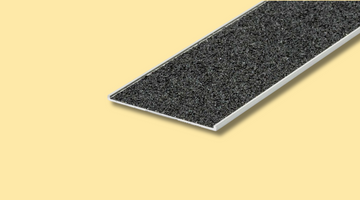Stair nosing might seem like just a decorative add on or a minor detail, but it plays a significant role in safety and aesthetics when it comes to stairs in Australia. Whether you are a homeowner looking to renovate your staircase or a builder working on a commercial project, understanding stair nosing is important. In this article, we will cover everything you need to know about stair nosing in Australia.Slips, trips, and falls are responsible for a significant portion of accidents in Australia, and public staircases pose a particularly high risk. Furthermore, the incidence of falls in residential spaces is on the rise each year.
This highlights the critical importance of stair safety for both homeowners and businesses. It is the duty of property owners, construction professionals, and facility managers to prioritise the safety of those using their buildings.
What is Stair Nosing?
Stair nosing is a protective and decorative edge that is installed on the front edge of stairs. It has many important purposes, with safety being paramount. Here are some key functions of stair nosing:
- Safety: Stair nosing provides an anti-slip surface on the edge of each step, reducing the risk of accidents caused by slips and falls. This is especially important in public places and high-traffic areas.
- Durability: Stairs are subject to heavy foot traffic, and the edges are vulnerable to wear and tear. Stair nosing adds an extra layer of protection to the stair edge, prolonging the life of the staircase.
- Aesthetics: Stair nosing comes in various materials and designs, enhancing the overall look of the staircase. It can complement the décor of your home or commercial space.
Types of Stair Nosing
In Australia, there are different types of stair nosing products available, each catering to specific needs and preferences:
Aluminium Stair Nosing: This type of nosing is highly durable and is often used in commercial buildings and public spaces. It is resistant to corrosion and comes in various colours and designs to match the aesthetics of the surroundings.

Fibreglass Stair Nosing: This is a composite material made primarily of fiberglass reinforced with a polymer resin. This combination of materials creates a robust and non-slip surface that is well-suited for stair applications.

Rubber Stair Nosing: Rubber nosing is known for its excellent slip resistance. It is commonly used in areas where safety is a top priority, such as schools and hospitals. Rubber nosing is also easy to maintain.
Wooden Stair Nosing: Wooden nosing adds a classic and elegant touch to staircases. It is commonly used in residential settings and can be stained or finished to match the interior décor.
Australian Building Codes and Regulations
When installing stair nosing in Australia, it’s essential to adhere to building codes and regulations to ensure safety and compliance. The Building Code of Australia (BCA) is one of the documents that contains guidelines for stair design and construction, including the use of stair nosing. Here are some key points to consider:
1. Dimensions: The BCA specifies minimum and maximum dimensions for stair nosing, ensuring that it provides sufficient grip without causing a tripping hazard.
2. Slip Resistance: Stair nosing must meet specific slip resistance requirements to reduce the risk of accidents. The BCA outlines the acceptable slip resistance values that stair nosing materials must meet.
3. Visibility: Stair nosing should be visually distinguishable from the surrounding surfaces to aid in step recognition and prevent accidents.
4. Continuity: Stair nosing should provide a continuous, even surface on the stairs, with no abrupt changes that could cause tripping.
Our eSafety Stair Nosing Range complies with the Australian Standards and Building Codes.
Is Stair Nosing a Mandatory Requirement?
Absolutely, it is. In accordance with AS1428.1, which is the Australian Standard for Designing Access and Mobility Part 1, the installation of stair nosings is obligatory for all new construction projects. This standard aims to enhance accessibility for individuals with disabilities and encompasses various aspects of building design, while also specifying the minimum criteria based on layout and usage.
Considering that stair nosings constitute an integral part of a staircase’s surface, it is essential to take into account the relevant slip resistance regulations when selecting materials and installing stair nosing.
Installation and Maintenance
Proper installation of stair nosing is crucial for its effectiveness. It should be securely attached to the stairs using appropriate adhesives or fasteners. Regular maintenance is also essential to ensure that the nosing remains in good condition. Cleaning, inspecting for wear and tear, and promptly replacing damaged nosing are all part of proper maintenance practices.
Stair nosing is a critical element of staircase design in Australia. It enhances safety, durability, and aesthetics, making it an essential consideration for homeowners and builders alike. By understanding the different types of stair nosing available and the standards required, you can ensure that your stairs not only look great but also provide a safe and functional space for all who use them. Whether you’re renovating your home or working on a commercial project, our team can assist you in choosing the right product for your application. You can also rest-assured that our product range complies with Australian codes and regulations.








